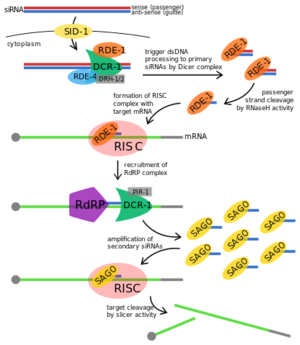Sandbox RDE-1
From Proteopedia
Contents |
Introduction
|
The rde-1 gene is a member of the Argonaute gene family. Proteins from "Argonaute" family form an evolutionarily conserved family whose members silence gene expression in pathways such as RNA interference (RNAi). Argonaute family proteins can be divided into two types, AGO and Piwi proteins, depending on the small RNA they bonded to. Both types of Argonaute proteins bind 21–35 nucleotide-long small RNA guides whose sequence identifies the genes to be silenced. [1] RDE-1 (RNAi-DEfective 1), a primary Argonaute protein, is required for RNA-mediated interference in Caenorhabditis elegans; thus, it is also known as RNAi promoting factor. Its gene locus was first characterized in C. elegans mutants resistant to RNAi, and was found to be a member of the Piwi gene family that includes plant, Drosophila, and vertebrate homologs. [2]
Structure
Three-dimensional structure of an entire "Argonaute" protein is not available, but a series of structures of eubacterial and archaeal Argonautes, as well as structures of individual domains of eukaryotic Argonaute proteins, together reveal broad principles that hold true in fungi, plants, and animals. All "Argonaute"/Piwi proteins possess three primary domains forming a crescent-shaped base: the PAZ, MID, and PIWI domains. The amino-terminal PAZ domain uses its oligonucleotide-binding (OB) fold to secure the 3′ end of the small RNA guide strand to Argonaute protein. A conserved hydrophobic cavity within the PAZ domain recognizes the characteristic two-nucleotide, 3′ overhanging end of the guide-passenger siRNA generated by Dicer. The MID domain anchors the 5′ monophosphate of a siRNA to the Argonaute protein, securing the guide through multiple cycles of target cleavage. In vitro, studies suggest that 5′ phosphate binding helps align the small RNA on the surface of Argonaute, ensuring that the correct bond of the target is positioned in the endonuclease active site. In other words, the PAZ and MID domains orient and anchor the double-stranded siRNA by binding to the 3’ and 5’ termini, respectively, leaving the internal nucleotides accessible for base pairing.
The carboxy-terminal PIWI domain resembles nuclease RNase H in which it folds into an RNase H-like structure. Like RNase H, the PIWI domain contains three negatively charged, evolutionarily conserved amino acids — typically aspartate-aspartate-glutamate (DDE) — that form a Mg2+-binding catalytic triad.
The PIWI domain folds into an RNase H-like structure, and contains the conserved catalytic triad “DDH” (two aspartate residues, one histidine residue). The crystal structure of RDE-1 has not been formally elucidated, but can be assumed to closely resemble its human homologs. RDE-1 protein consists of 1020 amino acids. [3] The PAZ domain contain about 110 amino acids, and the PIWI domain consists of 300 amino acids. [4]
Importance/Function

Disease
Relevance
This is a sample scene created with SAT to by Group, and another to make of the protein. You can make your own scenes on SAT starting from scratch or loading and editing one of these sample scenes.
</StructureSection>
References
- ↑ https://www.sciencedirect.com/science/article/pii/S0960982211005471
- ↑ Tabara, H.; Sarkissian, M.; Kelly, W. G.; Fleenor, J.; Grishok, A.; Timmons, L.; Fire, A.; & Mello, C. C. (Oct 1999). "The rde-1 gene, RNA interference and transposon silencing in C. elegans". Cell. 99 (2): 123–32. doi:10.1016/S0092-8674(00)81644-X. PMID 10535731
- ↑ Tabara, H.; Sarkissian, M.; Kelly, W. G.; Fleenor, J.; Grishok, A.; Timmons, L.; Fire, A.; & Mello, C. C. (Oct 1999). "The rde-1 gene, RNA interference and transposon silencing in C. elegans". Cell. 99 (2): 123–32. doi:10.1016/S0092-8674(00)81644-X. PMID 10535731
- ↑ https://www.sciencedirect.com/science/article/pii/S0968000400016418
- ↑ https://en.wikipedia.org/wiki/RDE-1#/media/File:Exogenous_RNAi_Pathway_in_C._elegans,_edited.svg
